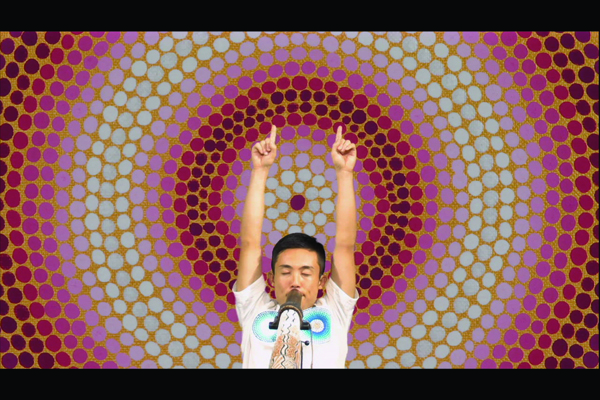In the first of our Tokyo International Film Festival roundups, our film writer, Christopher O’Keeffe looks at some of the movies that kept him so busy last week, with some pleasant surprises along the way.
Postcards From the Zoo
A little girl, lost in a zoo at dusk, wandering the aging park taking in the sights and sounds, seems untroubled by her situation. Cut to her as a young women having grown up living within a small community of outsiders who choose to live in the zoo, and we learn that she has formed close bonds with the animals as much as the people, and appears content within her slow-moving, surreal existence.
When a mysterious, magic performing cowboy arrives, Lana, the girl (pictured above), takes the opportunity to leave with him and, like an animal being introduced into the wild, encounters the outside world for the first time.
Lana’s naivety and approach is charming and its genuinely troubling to see her life drift into darker territories even as the girl herself has little trouble adapting to her changing world, relating her new surroundings to the behaviors of the animals of the zoo. Inter-titles relating to the animals punctuate the film, explaining zoological definitions analogous with the visitors and inhabitants of the zoo, and with Lana’s own movements.
There are some interesting characters, the magical cowboy is great, and the often dream like setting of the hazy, decrepit zoo make this Indonesian film from talented director Edwin a pleasant surprise.
Golden Slumbers
This documentary film from French-Cambodian filmmaker David Chou is from a special sub-section of the ‘Winds of Asia – Middle East’ category of the TIFF, aimed at discovering the history of Cambodian cinema.
Charting the boom in Cambodian films in the 60s and early 70s and the subsequent destruction of this industry when Pol Pot and the Khmer Rouge took control of the country, killing the majority of actors and filmmakers and destroying their work. Interviewing some of the few surviving artists from this period, the film documents the terrible loss of a wonderful episode in the country’s film history.
Each of the survivors has their own unique story of how they got into the business of filmmaking, how they survived the purge and ultimately how they cope with the loss of what was their life-work. Some can look back and laugh at the earlier times, one man clearly struggles to talk about his loss and gives a deeply moving account of the horror of occupation and his subsequent attempts to put his life back together.
The majority of films from this period have been lost forever but some material did manage to survive. The director makes us wait until the very end to see this footage, and while watching the film and hearing the old directors animated talk of miraculous, special effects laden fantasy scenes, we too feel the immense loss and yearning to see this old material.
The interviewees visit the sites of former film studios, cinemas and scene locations as they recall their colorful history and inform their children or inquisitive locals of a past remembered now by only a few. Chou has done a good job of recording a moving account of a time that clearly means so much to the few who survived to remember it in this touching, worthwhile documentary.
Flashback Memories 3D
Flashback Memories 3D charts the life of digeridoo performer, GOMA, up to and after an accident that left him with a brain dysfunction that results in memory loss and difficulty in retaining new information. The film uses a live studio performance of GOMA and his Jungle Rhythm Section band to drive a flow of images and information, mostly home video footage of GOMA throughout his life, moving art and animation.
Unfortunately the screening I saw was not in 3D as the director, Tetsuaki Matsue, had obviously intended, and there are certain sections where the band, shot in 3D and dwarfed against a backdrop of images, will have been more impressive than in its 2D form. The performance itself was revelatory and certainly overcame any misgivings I had over what a man could accomplish as a digeridoo artist. GOMA is clearly a very intense, accomplished performer and it was interesting to see his development as a musician while he travelled the world honing his skills.
The deep repetitive sound of the instrument itself though, while looking exciting at a live music event or club could not hold my attention in a cinema and by the last couple of performances I was ready for the music to stop. Very little information is given other than the documentary footage on the screen, details of GOMA’s neurological condition for example are kept to a minimum, more scientific insight into the changes in personality and psychology would have been interesting.
As it is, the viewer is forced to create an image of the man before and after his accident from the home footage alone which works in a way but makes for a rather simple narrative.
Soegija
Indonesian drama ‘Soegija’ is a look at the life and times of the first indigenous christian bishop Albertus Soegijapranata SJ and the lives of the people around him, covering the period of his appointment in 1940 up until Indonesian independence from Dutch rule in 1949.
Veteran director Garin Nugroho attempts to portray an important sweep of his countries history charting the welcome removal of the Dutch by the Japanese at the outbreak of war, the brutalities of Japanese occupation, the return of the Dutch after Japan’s defeat and finally the long awaited independence of the country.
What at first appears to be an interesting look at a country’s involvement in the war through the eyes of its civilians quickly descends into tedious, heavy handed melodrama. Characters drift in and out of the story, usually to the effect of having one big dramatic scene which leaves little impact. Everyone is a little flat and deeper motives just don’t come across.
The bishop himself is clearly revered as a national hero but it’s difficult to appreciate the extent of his efforts other than a few kind words here and there. It’s not helped by several glaring inconsistencies, a little girl who doesn’t appear to age a day over a five year period being one of the worst examples.
The film is shot nicely enough and there is an interesting story in there somewhere, fans of sentimental television dramas may find something to enjoy, but this film just doesn’t have the weight needed to support the events depicted.










